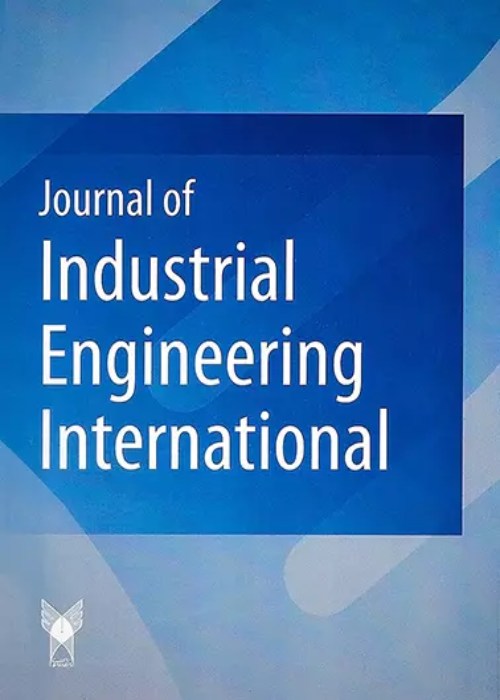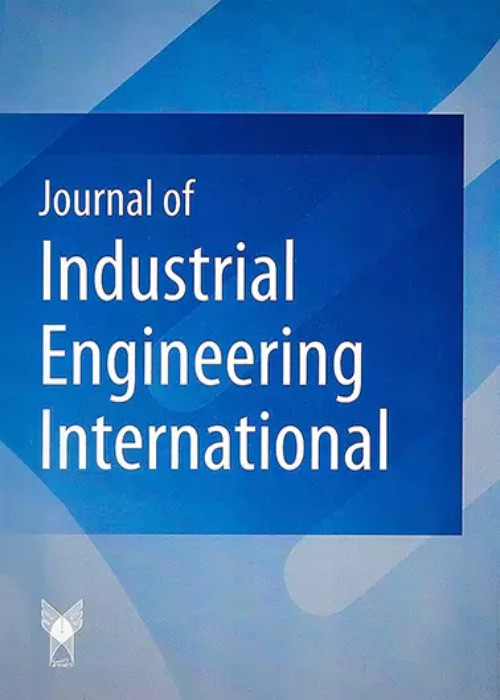فهرست مطالب

Journal Of Industrial Engineering International
Volume:18 Issue: 1, Winter 2022
- تاریخ انتشار: 1402/03/06
- تعداد عناوین: 7
-
-
Pages 1-7
The reliability of a system with three components, A, B, and C, coupled in series and parallel is investigated in this study. System A is a two-out-of-two linear consecutive system, System B is a one-out-of-one linear consecutive system, and System C is a two-out-of-four linear consecutive system. The failure of system B, or the failure of all system A and C components, can cause the entire system to fail. The system was evaluated using the Markov birth–death process, which resulted in clear expressions for availability and mean time to system breakdown. The effect of failure and repair rates on mean time to failure and availability has been graphically explored based on numerical values presented in a table and graph and assigned to system characteristics to demonstrate the effect of failure and repair rates on mean time to failure and availability, The results reveal that system effectiveness indicators like availability and mean time to system failure rise with repair rates and fall with failure rates.
Keywords: Accessibility, and Failure Rate are all terms that are used to describe the Accessibility, failure, repair rate -
Pages 9-23
The goal of this study is to provide an analytical framework for a standby serial sachet water plant. The plant is made up of five subsystems: a storage tank, filters, a tank, boosters, and a production machine, all of which are set up in a series-parallel configuration. The failure rates of both subsystems/units are continuous and supposed to tail exponential function, but repair is categories into the following; general repair for partially failed state while copula repair for complete failed state. A repair person is on-call 24 hours a day, seven days a week to repair failed units in the system. The transition diagram is used to obtain partial differential equations of degree one, which are resolved using supplementary variable procedure, Laplace conversion and MAPLE software, to derive expressions for numerous dependability agencies name; availability, reliability, MTTF, sensitivity MTTF, and cost of the sachet water plant. Arithmetical instances are delivered in order to demonstrate the achieved results and also to investigate the influence of parameters used. Tables and figures revealed that copula repair outperforms general repair in terms of returns.
Keywords: Availability, Reliability, Sachet Water, serial system -
Pages 25-40
Determining the factors affecting customer satisfaction in after-sales service in various industries has been studied. However, the importance of after-sales service by considering customer demographic factors in the automotive industry and its impact on organizational profitability needed further investigation. One hundred fifty-three thousand customers referring to the automotive after-sales service network examine the effect of customer income on the satisfaction and profitability of the organization. For this purpose, a sample of 383 people was randomly selected from different clusters of customers. The structural equation model in Amos 21 software was used to test the model and research hypotheses. The RFM clustering method was used to show the preferences and demands of customers in each cluster to address behavioral dissimilarity among customers. We also calculated the effect of each factor on overall customer satisfaction and profitability by presenting a mathematical model through multivariate regression equations. The results showed that the demographic variable of customers' income effectively affects their perception of satisfaction. Also, the level of customer satisfaction has a positive relationship with the organization's profitability. Finally, through mathematical equations, the numerical effect of each of the independent variables on the dependent variables, customer satisfaction, and profitability of the organization was calculated.
Keywords: Customer Satisfaction, Profitability, After -Sales Services, Regression, Automotive industry -
Pages 41-53
Due to the development of specialized quality management standards and the importance of product design and development in design and manufacturing organizations, the need to use them correctly and appropriately could help grow and improve the overall quality of the product. For this reason, in this article, we have focused on product design and development requirements in these technical quality management standards. Our methodology is the combination of careful study and numerical methods for analyzing the impact and overlap of the product design and development clause in technical quality management standards that have led to the proper choice of standard and the correct sequence of implementation for product excellence and maturity and the impact of each of these standards in the product’s maturity. Our most important findings are the weight of each of these standards on the maturity and quality of the product and the amount of growth resulting from the correct order of use in a defined period of time that can create up to 70% growth in product quality. Because product design is a specialized and complex process, these findings help better understand practical requirements and provide a consistent logical path to growth and overall quality based on these recommended standards that are worth using in organizations without Considering the scope of their activities.
Keywords: Management systems, Product quality, Excellence, International standards, Product development -
Pages 53-78
This paper proposes a bi-objective model for a green closed-loop supply chain network design. Four levels for forward and five levels for reverse flow were considered, including plants, distribution centers, online retailers, traditional retailers and customers for forward flow and customers, collecting centers, disposal centers, repair centers and plants for the reverse flow. The objectives are minimizing the GHG emission and maximizing profit by considering defective products and a second market for these products. Also, online retailers were considered alongside with traditional ones, since the Covid-19 pandemic has led to increase in the amount of online shopping. GAMS software and the Lpmetric technique were used to solve the model in the small and medium sizes. However, for the large size, we used Grasshopper Optimization Algorithm (GOA) as a meta-heuristic approach since solving the large size problem with GAMS is a complicated and time-consuming process. We provided Numerical and computational results to prove the efficiency and feasibility of the presented model. Finally, the managerial insights and future works were provided.
Keywords: CO2 emission, Defective product, Grasshopper Optimization Algorithm (GOA), Green Closed-loop supply chain, Mixed-integer programming -
Pages 79-96
Selection of the most influential factors to improve the performance of organizations has consistently been a significant task for project managers. These underlying factors aim to prevent the failure of the project and to improve the performance of employees. The success of the organization's projects is directly correlated to customer satisfaction, time, cost, and product quality at the time of project completion. In this paper, after reviewing the literature on the elements influencing the project's success, the extent to which each factor affects the project's success is accessed. A practical data evaluation method to predict the most underlying item is a machine learning algorithm, a perfect contributory method for project managers to examine the influential factors. After identifying the component with the highest effect on the project success, validating the selected items in a real-world practice paves the way for assessing that factor's effectiveness. In this study, after selecting the Agile approach as the most notable, the simulation models were utilized to measure the proportion of organizational performance improvement. Agile Management, which is considered in the actual case, signifies implementing the Scrum method and all the definitions and phases related to this method in the organization. The analyzed Agile practice (Scrum) for the case study decremented the project cost and time substantially and enhanced the service and product quality.
Keywords: Agile project management, Genetic algorithm, Machine learning, Scrum, Simulation -
Pages 97-104
In an approach proposed, Nasrabadi et al. (2014) characterized a subset of production points, the radial projection of which is located on the same facet of the production possibility set (PPS). They obtained the radial projection points by using CCR and BCC models. Some results were posited, which can help one obtain such a subset of the PPS. The sensitivity analysis of inefficient units is also provided. An interval has been achieved over which an individual input/output can be varied and, even then, its corresponding hyperplane does not change. In their proposed approach, two nonlinear programming problems need to be solved to estimate the above mentioned interval. These are, however, difficult to solve. In this paper, some new theorems have been proved so as to obtain a new formula to determine a subset of production points, the projection of which lies on the same hyperplane of the PPS. This new formula leads to the determination of the input preservation region and the output preservation region by solving two linear programming problems that have priority in calculation over the existing methods. To delineate our new approach, two numerical examples are provided at the end.
Keywords: DEA, reference hyperplane, radial projection point, preservation region, sensitivity analysis


